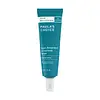What's inside
What's inside
 Key Ingredients
Key Ingredients

 Benefits
Benefits

 Concerns
Concerns

 Ingredients Side-by-side
Ingredients Side-by-side

Water
Skin ConditioningDicaprylyl Carbonate
EmollientCetearyl Isononanoate
EmollientGlycerin
HumectantPentylene Glycol
Skin ConditioningCetearyl Alcohol
EmollientSteareth-20
CleansingSafflower Oil/Palm Oil Aminopropanediol Esters
Skin ConditioningLaminaria Digitata Extract
Skin ProtectingOpuntia Ficus-Indica Stem Extract
Skin ConditioningArabidopsis Thaliana Extract
AntioxidantMarrubium Vulgare Meristem Cell Culture
Skin ProtectingLeontopodium Alpinum Meristem Cell Culture
Skin ConditioningRetinyl Palmitate
Skin ConditioningTocopheryl Acetate
AntioxidantTocopherol
AntioxidantMicrococcus Lysate
Skin ConditioningCaprylyl Glycol
EmollientHexylene Glycol
EmulsifyingLactose
HumectantGalactoarabinan
Lecithin
EmollientSchizophyllan
HumectantBeta-Glucan
Skin Conditioning1,2-Hexanediol
Skin ConditioningCarbomer
Emulsion StabilisingCellulose
AbsorbentMaltodextrin
AbsorbentC14-22 Alcohols
Emulsion StabilisingCetearyl Glucoside
EmulsifyingC12-20 Alkyl Glucoside
EmulsifyingHydroxypropyl Methylcellulose
Emulsion StabilisingDisodium EDTA
Sodium Hydroxide
BufferingPhenoxyethanol
PreservativeEthylhexylglycerin
Skin ConditioningSodium Benzoate
MaskingParfum
MaskingCI 77007
Cosmetic ColorantLimonene
PerfumingWater, Dicaprylyl Carbonate, Cetearyl Isononanoate, Glycerin, Pentylene Glycol, Cetearyl Alcohol, Steareth-20, Safflower Oil/Palm Oil Aminopropanediol Esters, Laminaria Digitata Extract, Opuntia Ficus-Indica Stem Extract, Arabidopsis Thaliana Extract, Marrubium Vulgare Meristem Cell Culture, Leontopodium Alpinum Meristem Cell Culture, Retinyl Palmitate, Tocopheryl Acetate, Tocopherol, Micrococcus Lysate, Caprylyl Glycol, Hexylene Glycol, Lactose, Galactoarabinan, Lecithin, Schizophyllan, Beta-Glucan, 1,2-Hexanediol, Carbomer, Cellulose, Maltodextrin, C14-22 Alcohols, Cetearyl Glucoside, C12-20 Alkyl Glucoside, Hydroxypropyl Methylcellulose, Disodium EDTA, Sodium Hydroxide, Phenoxyethanol, Ethylhexylglycerin, Sodium Benzoate, Parfum, CI 77007, Limonene
Cyclopentasiloxane
EmollientIsododecane
EmollientDimethicone Crosspolymer
Emulsion StabilisingNeopentyl Glycol Diheptanoate
EmollientCyclohexasiloxane
EmollientCaprylic/Capric Triglyceride
MaskingTocopheryl Acetate
AntioxidantRetinyl Palmitate
Skin ConditioningRetinol
Skin ConditioningTetrahexyldecyl Ascorbate
AntioxidantAstaxanthin
Skin ConditioningBisabolol
MaskingChamomilla Recutita Flower Extract
MaskingCamellia Sinensis Leaf Extract
AntimicrobialSalix Alba Bark Extract
AstringentVitis Vinifera Seed Extract
AntimicrobialGinkgo Biloba Leaf Extract
Skin ConditioningCalluna Vulgaris Flower Extract
Skin ConditioningVaccinium Macrocarpon Fruit Extract
AstringentRubus Idaeus Fruit Extract
AstringentBetula Alba Bark Extract
MaskingGlycine Soja Oil
EmollientSilica
AbrasivePhenoxyethanol
PreservativeCyclopentasiloxane, Isododecane, Dimethicone Crosspolymer, Neopentyl Glycol Diheptanoate, Cyclohexasiloxane, Caprylic/Capric Triglyceride, Tocopheryl Acetate, Retinyl Palmitate, Retinol, Tetrahexyldecyl Ascorbate, Astaxanthin, Bisabolol, Chamomilla Recutita Flower Extract, Camellia Sinensis Leaf Extract, Salix Alba Bark Extract, Vitis Vinifera Seed Extract, Ginkgo Biloba Leaf Extract, Calluna Vulgaris Flower Extract, Vaccinium Macrocarpon Fruit Extract, Rubus Idaeus Fruit Extract, Betula Alba Bark Extract, Glycine Soja Oil, Silica, Phenoxyethanol
 Reviews
Reviews

Ingredients Explained
These ingredients are found in both products.
Ingredients higher up in an ingredient list are typically present in a larger amount.
Phenoxyethanol is a preservative that has germicide, antimicrobial, and aromatic properties. Studies show that phenoxyethanol can prevent microbial growth. By itself, it has a scent that is similar to that of a rose.
It's often used in formulations along with Caprylyl Glycol to preserve the shelf life of products.
Retinyl palmitate is a form of retinoid. Retinoids are the superstar class of anti-aging ingredients that include tretinoin and retinol.
This particular ingredient has had a bumpy year with its rise and fall in popularity.
First, Retinyl palmitate is created from palmitic acid and retinol. It is a retinol ester and considered one of the weaker forms of retinoid.
This is because all retinoids have to be converted to Tretinoin, AKA retinoic acid. Retinyl Palmitate is pretty far down the line and has to go through multiple conversions before its effects are seen.
Due to this long and ineffective conversion line, the benefits of Retinyl Palmitate are debated.
Studies show Retinyl Palmitate to help:
Dermatologists say this ingredient is ineffective because it isn't used in high enough concentrations in cosmetics.
This ingredient used to be found in sunscreens to boost the efficacy of sunscreen filters.
The downfall of Retinyl Palmitate was due to released reports about the ingredient being correlated to sun damage and skin tumors.
While there is a study showing this ingredient to cause DNA damage when exposed to UV-A, there is no concrete proof of it being linked to skin cancer. It is safe to use when used correctly.
All retinoids increase your skin's sensitivity to the sun in the first few months of usage. Be especially careful with reapplying sunscreen when using any form of retinoid.
Currently, this ingredient is still allowed in cosmetics all over the world. In Canada, cosmetics must have a warning label stating the product to contain Retinyl Palmitate
Fun fact: This ingredient is often added to low-fat milk to increase the levels of Vitamin A.
Learn more about Retinyl PalmitateTocopheryl Acetate is AKA Vitamin E. It is an antioxidant and protects your skin from free radicals. Free radicals damage the skin by breaking down collagen.
One study found using Tocopheryl Acetate with Vitamin C decreased the number of sunburned cells.
Tocopheryl Acetate is commonly found in both skincare and dietary supplements.
Learn more about Tocopheryl Acetate